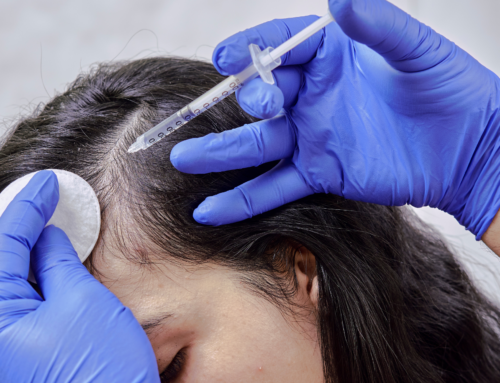When dealing with hair loss, it’s important to know when you’re winning, or if the hair loss is. If the pattern of hair loss continues or reverses, you need to know. One of the most important tools in determining the cycle of hair, and how you are progressing is a trichoscope, a device used by hair loss professionals, trichologists, and medical professionals.
Trichoscopy is the term coined for dermoscopic imaging of the scalp and hair. This novel diagnostic technique, both simple and non-invasive, can be used as a handy tool for diagnosing common hair and scalp disorders. A well-trained trichologist or hair loss professional will rely on the trichoscope for measuring and checking the hair follicle.
Diagnosing Androgenic Alopecia
Hair follicles are the tiny structures in your skin that produce and maintain your hair. The scope or size of your hair follicles can be important in diagnosing hair loss because it contains key information about the health and condition of your hair follicles. Female pattern hair loss (FPHL) and Male pattern hair loss (MPHL) both have visible patterns of hair loss, making a bedside diagnosis possible. However, there are cases of both female pattern hair loss and male pattern hair loss without any visible hair thinning!
The trichoscope can see vascular patterns, hair patterns, pigment patterns and interfollicular patterns. With the trichoscope, we can determine cicatricial and non-cicatricial alopecias… such as androgenetic alopecia, alopecia areata, telogen effluvium, tinea capitis, trichotillomania, lichen planopilaris, discoid lupus erythematosus and hair shaft disorders. The scope of hair follicles is significant in diagnosing conditions.
Types of Hair Loss
Hair loss is caused by many things, including genetics, hormones, nutritional deficiencies and autoimmune conditions. By examining the size and condition of hair follicles, trichologists, can often determine the specific type of hair loss a person is experiencing. For example, androgenetic alopecia (male or female pattern baldness) is associated with miniaturized hair follicles that gradually shrink over time. Other conditions, like alopecia areata, can lead to the sudden loss of hair in small patches with different characteristics. Visually seeing these differences will impact a diagnosis.
Assessing Hair Loss
The scope of hair follicles provides information about the extent and severity of hair loss in a particular area of the scalp. Follicles that have become miniaturized or are no longer producing hair tell us more about a specific condition and indicate advanced stages of hair loss. This can help determine treatment options and prognosis.
Monitoring Treatment Progress
It’s important for professionals and people undergoing a hair loss treatment program to track the changes in hair follicle size. This can help assess the effectiveness of any hair loss treatment. If the hair follicles start to regain their normal size and function, it may indicate treatment is working. This is key to the continued progress with our clients at Cellustrious®.
Understanding Hair Loss
Studying the scope of hair follicles is essential for researchers and scientists at Cellustrious® covering Lakewood Ranch, Bradenton and Sarasota, Florida. We continue to investigate the causes and mechanisms of hair loss and use that research to help with our in-office protocols and home kits. This information provides valuable insights into the underlying processes and potential targets for therapeutic interventions.
Personalized Treatment Plans
Besides diagnosing alopecia, trichoscopy can offer an alternative to unnecessary biopsies. However, if a biopsy is still needed, the scope can be helpful in choosing the ideal biopsy site. When we understand the specific characteristics of a person’s hair follicles, male or female, it will guide treatment plans specific to each patient. Different types of hair loss require different approaches. It is our goal to use the least invasive, most natural, plant-based peptide treatments when possible.
Scoping is an important diagnostic tool in assessing the type, severity, and potential causes of hair loss. At Cellustrious® trichoscopy is used as a valuable tool for evaluating the treatment response photographically during follow-up appointments. We use it to guide treatment decisions and monitor progress, to help patients with hair loss achieve better outcomes.





